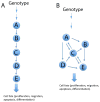Signaling networks in palate development
- PMID: 24644145
- PMCID: PMC3991764
- DOI: 10.1002/wsbm.1265
Signaling networks in palate development
Abstract
Palatogenesis, the formation of the palate, is a dynamic process regulated by a complex series of context-dependent morphogenetic signaling events. Many genes involved in palatogenesis have been discovered through the use of genetically manipulated mouse models as well as from human genetic studies, but the roles of these genes and their products in signaling networks regulating palatogenesis are still poorly known. In this review, we give a brief overview on palatogenesis and introduce key signaling cascades leading to formation of the intact palate. Moreover, we review conceptual differences between pathway biology and network biology and discuss how some of the recent technological advances in conjunction with mouse genetic models have contributed to our understanding of signaling networks regulating palate growth and fusion. For further resources related to this article, please visit the WIREs website.
Conflict of interest: The authors have declared no conflicts of interest for this article.
© 2014 Wiley Periodicals, Inc.
Figures




Similar articles
-
MiR-200b is involved in Tgf-β signaling to regulate mammalian palate development.Histochem Cell Biol. 2012 Jan;137(1):67-78. doi: 10.1007/s00418-011-0876-1. Epub 2011 Nov 10. Histochem Cell Biol. 2012. PMID: 22072420
-
Tak1, Smad4 and Trim33 redundantly mediate TGF-β3 signaling during palate development.Dev Biol. 2015 Feb 15;398(2):231-41. doi: 10.1016/j.ydbio.2014.12.006. Epub 2014 Dec 16. Dev Biol. 2015. PMID: 25523394 Free PMC article.
-
Molecular control of secondary palate development.Dev Biol. 2007 Jan 15;301(2):309-26. doi: 10.1016/j.ydbio.2006.07.042. Epub 2006 Aug 5. Dev Biol. 2007. PMID: 16942766 Review.
-
MiR-106a-5p modulates apoptosis and metabonomics changes by TGF-β/Smad signaling pathway in cleft palate.Exp Cell Res. 2020 Jan 15;386(2):111734. doi: 10.1016/j.yexcr.2019.111734. Epub 2019 Nov 23. Exp Cell Res. 2020. PMID: 31770533
-
TGF-β Signaling and the Epithelial-Mesenchymal Transition during Palatal Fusion.Int J Mol Sci. 2018 Nov 19;19(11):3638. doi: 10.3390/ijms19113638. Int J Mol Sci. 2018. PMID: 30463190 Free PMC article. Review.
Cited by
-
Periderm Fate during Palatogenesis: TGF-β and Periderm Dedifferentiation.J Dent Res. 2023 Apr;102(4):459-466. doi: 10.1177/00220345221146454. Epub 2023 Feb 7. J Dent Res. 2023. PMID: 36751050 Free PMC article.
-
Gene expression profiling in the developing secondary palate in the absence of Tbx1 function.BMC Genomics. 2018 Jun 4;19(1):429. doi: 10.1186/s12864-018-4782-y. BMC Genomics. 2018. PMID: 29866044 Free PMC article.
-
Systems biology of facial development: contributions of ectoderm and mesenchyme.Dev Biol. 2017 Jun 1;426(1):97-114. doi: 10.1016/j.ydbio.2017.03.025. Epub 2017 Mar 29. Dev Biol. 2017. PMID: 28363736 Free PMC article.
-
Closing the Gap: Mouse Models to Study Adhesion in Secondary Palatogenesis.J Dent Res. 2017 Oct;96(11):1210-1220. doi: 10.1177/0022034517726284. Epub 2017 Aug 17. J Dent Res. 2017. PMID: 28817360 Free PMC article. Review.
-
Pbx loss in cranial neural crest, unlike in epithelium, results in cleft palate only and a broader midface.J Anat. 2018 Aug;233(2):222-242. doi: 10.1111/joa.12821. Epub 2018 May 23. J Anat. 2018. PMID: 29797482 Free PMC article.
References
-
- Murray JC. Gene/environment causes of cleft lip and/or palate. Clin Genet. 2002;61:248–256. - PubMed
-
- Schutte BC, Murray JC. The many faces and factors of orofacial clefts. Hum Mol Genet. 1999;8:1853–1859. - PubMed
-
- Gritli-Linde A. Molecular control of secondary palate development. Dev Biol. 2007;301:309–326. - PubMed
Publication types
MeSH terms
Grants and funding
LinkOut - more resources
Full Text Sources
Other Literature Sources
Research Materials

